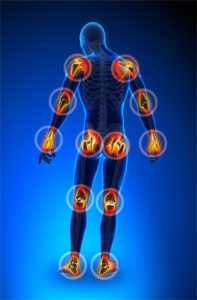Tendinitis is the inflammation of the tendon and results from micro-tears that happen when the musculotendinous junction is acutely overloaded with a tensile force that is too heavy and/or too sudden. Tendinitis is still a very common diagnosis, though research increasingly documents that what is thought to be tendinitis is usually tendinosis.
Tendinosis is a degeneration of the tendon’s collagen in response to chronic overuse; when overuse is continued without giving the tendon time to heal and rest, such as with repetitive strain injury, tendinosis results. Even tiny movements, such as clicking a mouse, can cause tendinosis, when done repeatedly.
Many injuries commonly presumed to be tendinitis are actually tendinosis. For example, tennis elbow is usually described as tendinitis of extensor carpi radialis brevis; however, research has shown “signs of either acute or chronic inflammation have not been found in any surgical pathologic specimens in patients with clinically diagnosed lateral tennis elbow syndrome,” proving that tennis elbow is not tendinitis. The histology of tennis elbow shows that it is actually tendinosis.
A microscopic view of tendinosis reveals an increase of immature type III collagen fibers (mature type I fibers dominate in healthy tendon tissue); loss of collagen continuity so that collagen fibers are no longer aligned with each other and sometimes fail to link together to facilitate load-bearing; an increase in ground substance (the material between the body’s cells); and a haphazard increase of vascularisation. These vascular structures do not function as blood vessels and are not associated with increased healing.
These changes result in a loss of strength in the tendon and increase the bulk of the tendon, both of which contribute to the cycle of injury and can set the stage for secondary conditions, such as tendinitis and nerve impingement.
The most important reason to distinguish between tendinitis and tendinosis is the differing treatment goals and timelines. The most prominent treatment goal for tendinitis is to reduce inflammation, a condition that isn’t present in tendinosis. In fact, some treatments to reduce inflammation are contraindicated with tendinosis. Ibuprofen, a nonsteroidal anti-inflammatory, is associated with inhibited collagen repair
Some of the separate treatment goals for tendinitis and tendinosis result in overlapping beneficial treatment methods. For example, deep-friction treatments are beneficial for both conditions, but for very different reasons. In the case of tendinitis, deep friction serves to reduce adhesions and create functional scar tissue once inflammation has subsided. In the case of tendinosis, deep-friction treatments serve to stimulate fibroblast activity and collagen production. Accurate assessment techniques and knowledge of the relevant condition will result in the most appropriate application of treatment.
The primary treatment goals for tendinosis are to: break the cycle of injury; reduce ground substance, pathologic vascularisation, and subsequent tendon thickening; and optimise collagen production and maturation so that the tendon regains normal tensile strength.
Treatments for both at The Twyford Clinic include:
Biomechanics
When assessing your biomechanics I see if your issue is being caused by another part of your body, this can include stiffness in a joint altering your movements and causing irritation in another area. This is fundamental to curing your pain by finding the cause of the issue. A great example I had recently was a 13 year boy attended with low back pain, after assessing him it did not present as a back issue and I noted his big toe hardly moved. He was a hurdler and had broken his toe 2 years previously. I only treated his toe and this cured the back pain. Every patient receives this level of assessment from knowledge I have picked up over 25 years of working at the highest level of sport and constant studying.
Ergonomic advice
Your biomechanics will be fully assessed and the demands on your body from work and personal activities will be reviewed. We will advise you on the best way to avoid irritation and return to a healthy lifestyle.
Ice and Heat
Ice leads to vasoconstriction and this can address the neovasularisation of the tendon tissue. Heat is also useful as it increases blood flow so enabling healing products to be delivered to the affected area.
Eccentric exercises
Very effective in stimulating collagen production and alignment and stimulates collagen cross-linkage formation, in turn improving tensile strength. This leads to some of the most effective long term improvements.
Frictions
Deep-friction massage applied to the tendon serves to stimulate fibroblast activity and generate new collagen. Massage stimulates circulation and cell activity, especially when done at the appropriate depth. Myofascial techniques and trigger-point therapy can reduce fascial restrictions, scar tissue, and trigger points in the muscle connected to the tendon, relieving tension on the tendon. Myofascial techniques, lengthening deep-tissue techniques, stretching and active-release techniques can reset muscle memory to a more lengthened position, reducing the tension placed on the tendon during activity.
All these techniques are utilised very effectively at The Twyford Clinic to help you gain the best results from your treatment.
For an appointment call 01962 714979

